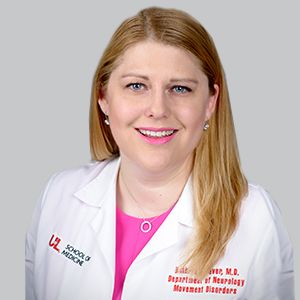Article
The Therapeutic Landscape of Parkinson, a Multi-System Disease
Author(s):
The director of the Movement Disorders Clinic at University of Louisville spoke about current therapies available for patients but stressed that they often don’t address the non-motor features.
Kathrin LaFaver, MD, Raymond Lee Lebby Chair in Parkinson Disease Research, Director of the Movement Disorders Clinic and Assistant Professor of Neurology at the University of Louisville

Kathrin LaFaver, MD
Kathrin LaFaver, MD, Raymond Lee Lebby Chair in Parkinson disease research, Director of the Movement Disorders Clinic, and Assistant Professor of Neurology at University of Louisville spoke with NeurologyLive about the current therapeutic landscape of Parkinson disease, noting that while there have been great strides made in this space, it can always be better.
LaFaver emphasized that while the discovery of dopamine and levodopa in the 1970s greatly aided therapies for Parkinson disease, most current available therapies don't address non-motor symptoms, which affect a patients' quality of life greater than motor symptoms.
Asked about CVT-301 or APL-130277, 2 new drugs that have been submitted as NDAs with the FDA for treatment of OFF episodes, LaFaver notes that these medications try to fill a need for this patient population, offering medication that is fast and rapidly acting. LaFaver adds that in an ideal situation, it would be best to try and manage patients so that this need doesn't arise.
NeurologyLive: Can you describe the current therapeutic landscape of Parkinson disease?
Kathrin LaFaver, MD: “It is amazing that we actually have so many medications now at our disposal for Parkinson. There always used to be this conception about neurology in general that we can always diagnose a disease and then there’s nothing to do, so neurologists were traditionally seen as great diagnosticians but not necessarily physicians who had a lot to offer therapeutically. Unfortunately, that is true for some disorders like for example ALS or Lou Gehrig’s disease, we often do not really have much in the terms of not a cure, but even symptomatic treatments.
For Parkinson disease the picture really does look different with the discovery of levodopa being helpful and dopamine being helpful in the 1960s, it really has made a big, big change and on that same note there’s not many medications available. Now with that being said, most of the treatment options we have are really for motor symptoms of Parkinson, meaning for tremor, slowness of movements, stiffness, rigidity of body and extremities. Parkinson is, however, a multi-system disease and so for many of the so-called non-motor features, the treatment options are unfortunately not as good and that is especially true for Parkinson associated memory problems, for balance problems that often lead to falls in later stages of diseases and also for bowel and bladder issues.
What do you think are the biggest challenges in the space?
KF: “I think we have made great strides in addressing motor symptoms of Parkinson, although we can always get better, and again for people in more advanced stages experiencing OFF/ON fluctuations and dyskinesia, there are now, for example, surgical options that like enteral infusion of levodopa and deep brain stimulation surgery, but again all these available therapies often don’t address the non-motor features. For example, memory loss or near-stage dementia addresses many patients, if you look at 20 years after disease onset, it affects a majority of people with Parkinson disease and there’s very limited interventions we have to offer and then the same is true for the interventions for falls and balance and along those lines also mood, I didn’t mention that earlier, but depression we certainly have ways to treat depression but again, it’s often that underrecognized aspect of Parkinson. There’s been studies showing really that these non-motor symptoms and especially memory/mood symptoms actually affect the quality of life even greater than the motor symptoms.
Are there any common misconceptions that need to be addressed?
KF: “I think one of the big misconceptions is around what many people call levodopa phobia or dopamine phobia. There has been a misconception in the 1970s that levodopa, the medication most commonly used for Parkinson, that it is has sort of a certain shelf life that only works for a certain number of years and if you start using it too early, that the patients will ultimately pay for it. We definitely know now from multiple observational, long-term studies going over 20 years in the UK and Australia, and there also was recently a study comparing patients in Italy and Ghana to kind of compare if it makes a difference for patients if medicines are started earlier versus later in the disease and does it prevent long-term complications if we start medications later, and that is not the case.
Our goal now always should be to give patients the best quality of life at each stage in the disease and there’s no need to withhold treatment, that the assumption like saving the best effect for later, because that is really a false conception that it is even necessary or beneficial to do.”
Both CVT-301 (Acorda) and APL-130277 (Sunovion) have been filed as NDAs with the FDA, if these are approved, how will these treatments help patients with OFF episodes?
KF: “The first medication, CVT-301, is an inhaled levodopa/nasal spray levodopa and the second, APL-130277, is the sublingual apomorphine. Both of these medications address a need in more moderately-to-advanced stages of Parkinson, where people develop what is called motor fluctuations or OFF symptoms. That arises because the patients’ brain basically produces less and less dopamine as the years go along and patients become reliant really on the external dopamine medication, essentially. So, unfortunately, this is the classic carbidopa-levodopa, but has a short half-life and they kind of have a peak effect and it often wears off and they often experience these OFF times which can be quite disabling.
Both of these new medications try to fill this need for patients that experience OFF symptoms to have a medication available that is very fast, rapidly acting and can help with these OFF periods, and trying to find a way to do the delivery of these things rapidly and conveniently. Now in my mind, it would be even better if we try to manage patients so that this need doesn’t even arise, or not at least that much, and so there are other product developments that are already on the market that have carbidopa-levodopa with a more extended half-life. There’s the Impax, a company that produces Rytary, with a longer half-life, then there’s this Accordion Pill developed, and there’s several other developments coming in the market that are being studied right now that try to give levodopa a longer half-life but have a more even distribution throughout the day, and in my mind that would actually be the most ideal scenario.
Currently, we start people on carbidopa-levodopa that’s a 3x a day dosing medication and that enough can be hard enough to do, and everyone who’s a parent, like myself, it’s always so easy for us from a physician side to tell people, “Oh just take it 3x a day” and being a parent, trying to give your kid antibiotics 3x a day, it’s sometimes is an eye opener because it makes you realize how hard this can be and how easy it is to forget a dose. And that’s just the starting point, and then as people go along, we might change their dosing to 4, 5 or even 6 times a day of carbidopa-levodopa dosing. People often are compliant with this because if they miss a dose, they really feel bad, these OFF states can be very disabling, but it’s really less than ideal to require patients to take medications around the clock—it can really be difficult and hamper quality of life.
In my mind, developing a better strategy to make the levodopa really more longer-acting, and we already have some products on the market that I mentioned the Rytary and some dopamine agonists which are longer acting, would be kind of the first line option for improving the situation, but again, it’s never going to be perfect, but some people even though they are optimally managed, have these sudden OFF sometimes on medication, so these products can both fill the niche and be sort of a faster acting mechanism to get more functional again.”
Transcript edited for clarity.





